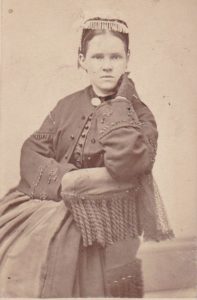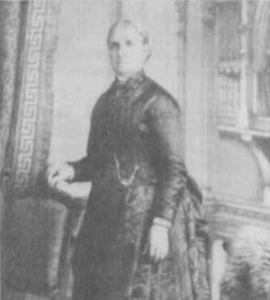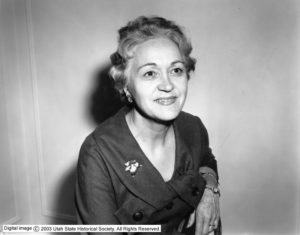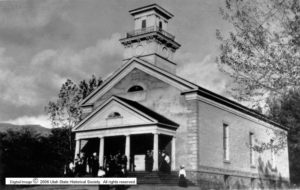UTAH WOMEN’S HISTORY / Explore the History / Utah Counties / Davis

Davis County
Key Players
Farmington Woman Suffrage Association
While 19 Utah counties eventually had suffrage associations, few records remain to give us details about these organizations and the people involved in them. Luckily the minutes have survived for the Farmington City’s Woman Suffrage Association; they give us a glimpse of the tremendous influence this group had on the suffrage movement in Utah and nationally. Founded on April 13, 1892, with 22 members, the membership soon grew to 49, with meetings held twice a month. English immigrant Elizabeth “Lizzie” Coombs was the first president, with Clara Stayner, Minerva Knowlton, Emeline Hess, Leone Rogers, and Hattie Knowlton initially filling other leadership roles.
Just like associations in Bountiful, Salt Lake City, or Beaver, members of the Farmington Woman Suffrage Association used the movement as an opportunity to prepare themselves for the time when they would be allowed to vote. Meetings featured history, lectures on civics and current issues of the day–ranging from the silver and tariff controversies to the U.S. Constitution to what constituted a just war. Members encouraged each other and urged the public to support women’s suffrage through newspaper articles, petitions, and speeches at public events.
Lucy A. Clark

Lucy Augusta Rice Clark. Photograph courtesy of Lori Billings Smith, a great-great-granddaughter.
Lucy Augusta Rice was born on March 5, 1850, and raised in Farmington, Utah by pioneer parents who taught her to be industrious and frugal. Her brother-in-law said that she was “…the smartest woman in town,” and her daughter said, “…mother was a natural-born leader and financier.” She taught school in Davis County before she married Timothy Baldwin Clark in 1867, and together they had 11 children. Education was very important to her, and she encouraged all of her children to attend college.
Clark was very interested in public affairs and held leadership roles in many organizations, including groups for both young women and children in the Church of Jesus Christ of Latter-day Saints. Clark was also one of the founding members of the Utah Women’s Press Club when it was organized in 1891, and was very involved in suffrage work during the years when Utah women were disenfranchised. As president of the Davis County Woman Suffrage Association and vice president of the Utah Woman Suffrage Association, Clark played a leading part in organizing the Utah women’s exhibit at the 1893 Chicago World’s Fair, where they presented their case to the world. She was one of three female candidates for the Utah Senate in the 1896 election, the first in which Utah women could run for office. Although she was defeated, she was appointed postmistress of Farmington shortly afterward. In 1900, while serving as vice president of the Utah State Council of Women, she was a delegate to the national suffrage convention in Washington, D.C. and testified before a Senate committee in favor of suffrage for the women of the nation. Clark was one of the first two women to be seated at a Republican National Convention, in 1908.
Clark believed in the women’s suffrage movement to her core. At a suffrage conference in Utah, she said, “Women’s sphere is as varied as the hues of water and that always depends on the vessel which holds it; sometimes it is like a little stream bubbling up from some fountain, sometimes like a little brook and again as a mighty river bearing upon its bosom the destinies of nations, and when the last barrier to woman is removed and the ballot is placed in her hands then will she surely be a helpmate to man.”
Elizabeth Walker Coombs

Elizabeth Walker Coombs. Photograph in My Farmington, 1847-1976, by Margaret Steed Hess,
An immigrant from England, Elizabeth Walker Coombs became a businesswoman and suffragist in Farmington. Working with her husband, she operated the first telephone office in Farmington, as well as a molasses mill and a store. Coombs was elected the first president of the Farmington Woman Suffrage Association in 1892 and led monthly suffrage meetings, sometimes at her own home. Speaking after her election as president in the first suffrage meeting in Farmington, “Lizzie” declared that she “did not feel to shrink from a duty, although it was a trial for her to stand before so large an audience…I feel that we have some rights and we should organize and study, that we may become intelligent on these subjects, and be able to teach our children. Women should not be taxed without having a voice.” Coombs continued her political engagement after suffrage was regained for Utah women in 1896–she served as a delegate to the Davis county and Utah state Democratic conventions that year.
Ivy Baker Priest

Ivy Baker Priest. Photograph courtesy of the Utah State Historical Society.
Ivy Baker Priest became active in politics in Davis County and rose to be one of the most prominent political organizers of women in the 1950s. She served as the Treasurer of the United States and was twice elected Treasurer of the State of California. She was a lifelong advocate of involving more women in the political process, while acknowledging the challenge of balancing her professional responsibilities with raising a family. Read more here.
Key Events
Coming soon.
Key Sites
Bountiful Tabernacle

Bountiful Tabernacle. Photograph courtesy of the Utah State Historical Society.
The Davis County Woman Suffrage Association often held meetings in the Bountiful Tabernacle between 1892 and 1895. These county-wide suffrage meetings attracted large crowds with speakers from the territorial suffrage association in Salt Lake City.
Share Your History
We would love to hear from you about the women’s advocates in your family or community. Send us an email at stories@betterdays2020.org.

